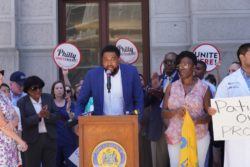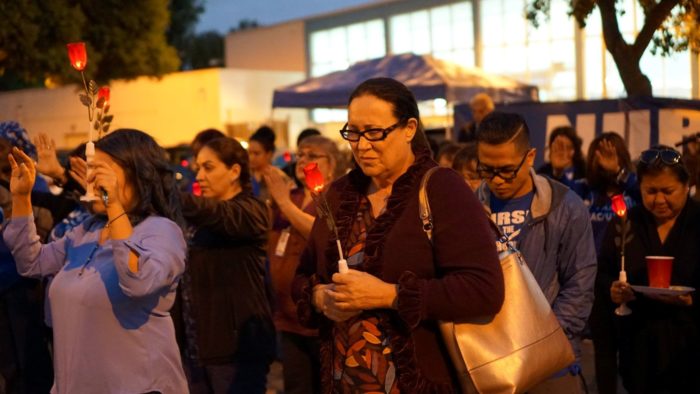The Cost of Care
Across the country, unions are standing up for patients
as for-profit ventures bankrupt hospitals and
compromise community health

Sandi Marques, RN, has spent 30 years at St. Francis Medical Center, caring for the people she went to elementary, junior high and high school with—some of the least healthy and least insured families in southeast Los Angeles County. St. Francis declared bankruptcy in 2018, and despite new bids for ownership, key services such as emergency, oncology and charity care remain on the chopping block.
Marques, also a union representative to nurses hit by the financial struggles, told representatives from the California State Attorney General’s Office considering the fate of St. Francis: “As the daughter of a single mother who was employed but often underinsured, I understand having to choose the emergency room instead of a physician’s office. The communities of St. Francis deserve access to all the services we provide here.”
On the East Coast, Hahnemann University Hospital, a 496-bed teaching hospital in the heart of Philadelphia also filed for bankruptcy and is shutting down completely. Union leader Chris Woods is mourning the loss of his grandmother, Emma Woods, a longtime Hahnemann employee and a union activist. Chris Woods, executive vice president at District 1199C, National Union for Hospital and Health Care Employees, is also standing up to corporate greed and following his grandmother’s legacy. His mission: Stand up for hundreds of displaced workers and for thousands of families who now must scramble elsewhere to treat traumas, have their babies and receive life-saving management of chronic conditions.

“This is the hospital I grew up in,” he said. “And when you see things like this happen, it just opens your eyes to the work that has to be done about the for-profit companies coming into health care and how disruptive they can be to the community.”
The stories of St. Francis and Hahnemann are familiar: nonprofit hospital in an underserved urban or rural community becomes a for-profit hospital and then ends up in financial distress, namely bankruptcy. As the social mission of keeping the vulnerable healthy gets sacrificed on the altar of financial viability, unions are stepping in to lead with power and compassion.
Union power and compassion
“It’s easy to come up here and make judgments based on numbers without looking at the people we serve,” said Helene Mendez, an ICU registered nurse who testified alongside Marques at the St. Francis hearing, which turned out nearly 200 nurse members of United Nurses Associations of California/Union of Health Care Professionals (UNAC/UHCP) to a Lynwood community hall. Last fall, UNAC/UHCP nurses at the Parkview Community Hospital Medical Center in Riverside led efforts to save threatened resources in that hospital bankruptcy.

“It’s time for Parkview to be better staffed, better equipped, and better prepared to serve this community,” said Yvette Harris, RN, who grew up in the Parkview neighborhood in Riverside and works at the hospital.
Unions have proven time and time again that we understand what it means to support the communities where we live, work and provide care. In tough times, we’ve rallied, marched, testified at hearings, told our own stories and stepped up and agreed to significant changes to our own contracts – all to ensure that hospital doors would stay open and keep serving our patients. Sometimes we’re successful; sometimes the financial burdens created elsewhere outweigh our sacrifices.
In Philadelphia, hundreds of members from District 1199C and Pennsylvania Association of Staff Nurses and Allied Professionals (PASNAP) have rallied, handed out leaflets, testified, Woods said. These workers and other labor allies were even joined by Bernie Sanders at one rally. How absurd, Sanders and other leaders said, was it for an investment banker to be allowed to own a medical center instead of an owner committed to “the health of a population rather than the size of a portfolio.”

“I don’t think we have been calling them out enough,” said Woods, who added that the union is taking on the political establishment in the city and will sue to keep the bankrupt owners from shielding Hahnemann’s valuable real estate near downtown Philadelphia for future development sales. “I’ve been vocal: We are not going to stand for that.”
More nonprofit health care facilities have been acquired by or converted to investor-owned organizations, which now own an estimated 15 percent of all general hospitals in the United States. Many of the hospitals that go bankrupt and/or shut their doors are in urban or rural communities, where patients are low-income and suffer health disparities. Hospitals have been affected in California, Oklahoma, Florida and Pennsylvania, to name a few. Said UNAC/UHCP President Denise Duncan, RN: “It’s the same story. This is absolutely not what our country should be about.”
Patients over profits
At Hahnemann, which included the loss of 600 NUHHCE positions, the wave of concern was not only for the displaced health care workers but for care access in historically underserved neighborhoods. “I talked to a young woman who had been getting her prenatal care and was ready to give birth here this month and now has to find another place,” Woods said.
Maria Garcia Bulkley came to one of the rallies in her wheelchair and hooked up to an IV bag and machines monitoring her vital signs. Bulkley, physician assistant at another hospital, told a Delaware radio station that she received treatment for non-Hodgkin’s lymphoma at Hahnemann since February. Hahnemann is set to close this month, and the prospect of going elsewhere for her cancer-fighting medicine left Bulkley “stressed and sad.”
“I wanted to do the final treatment with my new ‘second family’ and celebrate with them when it was over. It’s a little selfish, but it means a lot to me. They have gotten me through this,” she said.
At Parkview and St. Francis, the hospitals remain open but key services could be lost to communities where the social conditions under which people are born in, grow up in, live in, work, and grow old strongly influence their overall health. As such, these neighborhoods often fare worse than other communities in terms of measurable health outcomes, especially coupled with the fact that many families are low income, uninsured, and under-insured.
UNAC/UHCP incoming executive director Joe Guzynski said, “In addition to the medical services and the compassionate care provided by the nurses, St. Francis provides something more—something more that is important to those who reside here—St. Francis provides a significant level of needed charity care and community benefits.”

St. Francis community members signed petitions and started a social media campaign to declare the positive impact of the St. Francis medical services on the neighboring residents—many of whom lack sufficient income, food, housing, insurance and transportation to remain healthy.
As one resident said, no matter who purchases the hospital, the cost of losing trauma, cancer and charity care is the math that matters.
Jeffree Davis, a 23-year-old Lynwood, CA, activist who lost his father to cancer, makes the case for hospitals to put the community’s health first: “I can’t imagine what it would be like if this hospital wasn’t right in our neighborhood. It’s not like a 7-Eleven on each corner. Communities like ours depend on these cancer units. We depend on St. Francis for the equipment, the care and the people. We can’t afford to go elsewhere. So, I stand up for this community. I am proud to stand for humanity over profits.”
—Anjetta McQueen Thackeray
“We depend on St. Francis for the equipment, the care and the people. We can’t afford to go elsewhere.”
—Jeffree Davis, Lynwood, CA, activist
PROFITS: St. Francis was one of the five general acute care hospitals in the Daughters of Charity Health System (DCHS), until 2015 when DCHS closed a deal with Verity Health System (VHS). VHS filed for Chapter 11 bankruptcy in 2018. Almost a year later, the bankruptcy court approved the sale of the hospital to KPC, a multi-billion-dollar conglomerate. In purchase documents, KPC signaled intent to significantly reduce charity care, limit access to emergency and trauma services, and fully eliminate cancer care and services.
PATIENTS: In the St. Francis coverage area, lung cancer, breast cancer, cervical cancer and colorectal cancer are all more fatal than in the rest of Los Angeles County—mainly because patients have income and transportation issues that keep them from recommended cancer screenings and early life-saving cancer diagnoses. Residents in St. Francis’ coverage area are also more likely than other Los Angeles County residents to suffer from other conditions and diseases.
“When you see things like this happen, it just opens your eyes to the work that has to be done.”
—Chris Woods, executive vice president, District 1199C, NUHHCE, which represents about 800 health care workers at Hahnemann
PROFITS: The ownership of Hahnemann changed hands in January 2018 when American Academic Health System (AAHS) bought the medical center and St. Christopher’s Hospital for Children from Tenet Healthcare Corp. for $170 million. California-based AAHS was never able to get Hahnemann on sound financial footing. Earlier this year, AAHS President Joel Freedman said the health system had no option but to close Hahnemann.
PATIENTS: Hahnemann’s ER served about 56,000 people a year—more than 150 a day. Most of Hahnemann’s patients are Latino and African American and live in some of the city’s poorest, sickest neighborhoods. The 170-year-old hospital also ran the city’s only Sexual Assault Nurse Examiner program, which employs nurses who are trained to collect evidence.